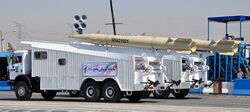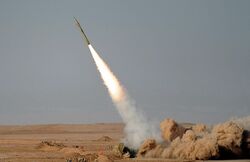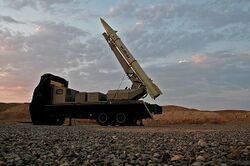Engineering:Fateh-110
| Fateh 110 | |
|---|---|
 Fateh-110s in Iran's in "Great Prophet-7" military exercise, 2012 | |
| Type | Tactical SRBM |
| Service history | |
| In service | 2002–present |
| Used by | See Operators |
| Wars | Syrian civil war |
| Production history | |
| Manufacturer | Iran |
| Specifications | |
| Mass | 3,500 kg |
| Length | 8.90 m |
| Diameter | 0.60 m |
| Warhead | high explosive or submunition |
| Warhead weight | 500 kg |
| Engine | Single stage, solid fuel rocket |
Operational range | 300 km |
| Speed | Mach 4 |
Guidance system | Inertial & electro-optical terminal (according to Iranian state media)[1] GNSS (according to Western analysts)[2] |
| Accuracy | 100 m CEP |
Launch platform | mobile launcher |
The Fateh-110 (Persian: فاتح-۱۱۰ "conqueror"), also known as NP-110[3] is an Iranian solid-fueled surface-to-surface ballistic missile produced by Iran's Aerospace Industries Organization since 2002. It is single-stage, road-mobile and can carry a high-explosive warhead of up to 500 kg. Four different versions, the Fateh-110A, 110B, 110D-1 and Fateh-E Mobin were developed with varying accuracy.[4] The latest version (Fateh-E Mobin), first shown to the public in August 2018[4] reportedly has a range of 300 km is reportedly more accurate than previous versions.[5][4]
The Fateh-110 was reportedly developed from Iran's Zelzal-2 unguided artillery rocket.[1] A version of the Fateh-110 is also license-built in Syria as the M-600. The missile has been used in the Syrian Civil War by Iran and Syria. It's presence in Syria was cited as a reason for the USA transferring two Patriot missile defense systems to Turkey in 2012.[4][6]
Development
After the Iran–Iraq War, Iran found out that it needed an accurate short-range missile, as its Zelzal and Naze'at rockets were unguided rockets and very inaccurate. Thus, 200 Chinese CSS-8 short-range missiles were bought in 1989.[7] But those missiles did not satisfy Iranians because of their short range, relatively light warhead and bulky structure. So a project was assigned to Shahid Bagheri Industries to design and produce a guided short-range missile.
Development began in 1995 and Zelzal 2 was chosen for the basis of the missile. Reportedly Syria also joined the program and produced its version called M-600.[8] In 2006 the US Department of the Treasury accused Great Wall Industry, a Chinese corporation and its partners for playing a lead role in the development of the Fateh missile system, as Iran had no previous experience with solid fuelled ballistic missiles.[9][10] The first tests, which occurred in 2002, were successful, and the missile was put into production.
Design
The Fateh-110 has three sets of fins. Four at the end of it near the exhaust, four other triangular shaped fins just above them and four small ones in front of missile near the nosecone. Of the three sets of fins on the missile, only the front ones are movable.
Transport
The Fateh-110 is road-mobile It uses three different transporter-erector-launchers (TELs). The first one has a similar mechanism with SA-2 and is based on a Mercedes-Benz 6x6 truck. The second TEL is also used by newer versions of Zelzal rockets and again uses the Mercedes-Benz platform. The third one is an indigenous TEL called Zolfaghar that is able to carry two missiles instead of one.
Variants
First generation
The first generation of the Fateh-110 had a range of 200 km with a CEP of 600 metres. It was flight tested in September 2002, began mass production shortly thereafter and entered service.[11][12]
Second generation
In September 2004, the second generation Fateh-110B was unveiled, with the range improved to 250 km and the same accuracy of its predecessor.[12] This version appears to be offered for export.[13]
Third generation
In 2010, the third generation Fateh-110 was tested by Iran. Iranian defense minister Ahmad Vahidi stated that accuracy, range, reaction time and storage capability in different parts of the country are increased. After that Iranian TV provided footage of the test and the impact.[14] Some time later, it was delivered to IRGC.[15] The range of the missile was stated as 300 km.[16][12]
Fourth generation
In August 2012 Iranian state media reported a successful test-firing of its fourth generation Fateh-110.[12] Iranian media reported that it's accuracy had been improved.
M-600
The Syrian M-600 is reportedly based on the second generation Fateh-110 (Fateh-110B).[17] In 2010 Israeli officials stated that the Syrian government had given hundreds of M-600 missiles to Hezbollah.[18]
Anti-ship ballistic missile variants
In 2014, the Islamic Revolutionary Guard Corps announced two variants of the Fateh-110 which they called the "Hormuz-1" and "Hormuz-2".[4] The Hormuz-1 was reportedly an anti-radiation missile and the Hormuz-2 was reportedly an anti-ship missile. Analysis by Anthony Cordesman with the Center for Strategic and International Studies suggests that the Hormuz-2 is "essentially the same as the Hormuz-1".[19]
Another anti-ship version with a 700-km range and designated Zolfaghar Basir was announced by the IRGC in September 2020.[20]
Zolfaghar
The Zolfaghar is an Iranian tactical ballistic missile believed to be based in the Fateh-110 family and the first ballistic missile of any sort openly used by Iran in a foreign conflict.[21] Unlike the other members of the Fateh-110 family, which are often described as quasi-ballistic missiles, the Zolfaghar flies a true ballistic trajectory. The missile's claimed range of 700 km is considered largely true based on the 2017 Deir ez-Zor missile strike; this apparently results from replacing the metal body of the Fateh-110 with composite, saving substantial weight. However, doubts have been raised about its reliability and accuracy, and Jane's assesses that the Zolfaghar's performance is poor.[21]
The Zolfaghar (and possibly other members of the Fateh-110 family) are believed to use commercial GNSS systems to improve accuracy.[2] Zolfaghar serial numbers may begin "ZB–".[22]
Fateh Mobin
In 2018, Iran unveiled the Fateh Mobin guidance kit, an upgrade for Fateh-110 missiles. According to Iranian Defence Minister Amir Hatami, it can be retrofitted to members of the Fateh-110 family up to the Zolfaghar.[23] The Fateh Mobin is believed to be an infrared imaging sensor for terminal guidance.[23]
Fath-360 (BM-120)
It was first shown in a military exhibition on August 21, 2020, under the name of Fath. In September 2022, Iran tested the Fath 360 (and its export model called BM-120), the downsized member of the Fateh ballistic missile family. The missile is 4 m (13 ft) long with a diameter of 30 cm, weighs from 850–1,100 kg (1,870–2,430 lb) with a 150 kg (330 lb) warhead, and has an 80–100 km (50–62 mi) range; it is guided by satellite navigation, most likely GLONASS and has a CEP of less than 30 meters. Its launch velocity is 3,704 km/h (2,302 mph; Mach 3.0), which increases to 5,000 km/h (3,100 mph; Mach 4.1) by the time of impact. Two, four, or six-round canisters can be mounted on a truck-based launcher.[24]
Table
| Variant | Range | Warhead weight [citation needed] | Notes | |
|---|---|---|---|---|
| Fateh-110 first generation | 200 km | 650 kg | Mach 3.5 | First variant. |
| Fateh-110 second generation | 250 km | 450 kg | Mach 3.7 | Announced in 2004. Also known as Fateh A-110 and Fateh-110A[25] |
| Fateh-110 third generation | 300 km | 650 kg | Mach 3 | Announced in 2010. Reports say that accuracy is also increased.[26] This variant is not named and is referred to by a variety of shorthand notations, such as "Fateh-110 block 3"[25] or "Fateh-110 Mod 3."[27] |
| Fateh-110 fourth generation | 300 km | 650 kg | Mach 3 | Addition of a new guidance system with "100% precision". Shown in 2012.[28] Also known as "Fateh-110-D1"[citation needed] |
| Khalij Fars | 300 km | 650 kg | Mach 3 | Anti-ship ballistic missile based on Fateh-110. Unveiled in 2011.[29] |
| Hormoz-1 | 300 km | 450–600 kg | Mach 4–5 | Anti-ship / anti-radar (ARM) ballistic missile.[30] |
| Hormoz-2 | 300 km | 450–600 kg | Mach 4–5 | Anti-ship / anti-radar (ARM) ballistic missile in May- 2014.[30] |
| M-600 or Tishreen | 250 km | 450 kg | Mach 3.7 | Syrian variant |
| Fateh-313 | 500 km | – | Mach 5 | Successor to Fateh-110 versions.[31] |
| Zolfaghar | 750 km | 579 kg | Mach 7.5 | newest version with submunitions warhead unveiled in 2016.[32][33] |
Operational history
Iran
As of 2017, Iran is assessed as having less than 100 launchers for all Fateh-110 variants.[34] Iran used the Fateh-110B against Kurdish dissidents in Iraq in 2018.[35] It is believed that during the January 8, 2020 missile attack of the US military bases in Iraq, Iran used the Fateh-110 missile.[36]
Syria
On 3 and 5 May 2013, Israel said it had hit a shipment of Fateh-110 in Syria that were "destined for Hezbollah". Israel said it would not tolerate "game changing weapons" falling into the hands of Hezbollah.[37][38] On 18 May Israeli media claimed that the Syrian army had aimed a battery of Tishreen missiles, Syria's version of Iran's Fateh-110, at Tel Aviv according to reconnaissance satellites. These missiles are believed to see possible use as a deterrent against further Israeli airstrikes on Syrian targets.[39]
According to two unnamed U.S. military officials, the Syrian Government fired at least two Fateh A-110 missiles in late December 2012. The firing of these missiles appeared to be an effort to more precisely target Syrian rebels.[40]
In late November 2014, Iranian and Lebanese sources confirmed that Hezbollah had received Iranian Fateh-110 guided ballistic missiles and inducted them into their missile arsenal. With a 250–350 km (160–220 mi) range, Fateh-110 missiles fired from Lebanon could hit targets anywhere in Israel up to the northern Negev. Israel has regarded deliveries of such missiles as justification for preemptive response, as the previous year it attacked missile shipments, transport convoys, and storage sites in Syria and Lebanon to prevent these and other missile types from being acquired by Hezbollah.[41]
Iraq
On 13 March 2022, 12 Fateh-110 missiles were used in the Erbil missile strikes.[42] On 15 January 2024, Fateh-110 missiles were reportedly launched during the Erbil attack.[43]
Operators
State-operators
 Iran
Iran Syria
Syria
Non-state operators
Hezbollah – In 2014, the IRGC confirmed that Iran had delivered Fateh 110 missiles to Hezbollah.[44] Israel had previously claimed that Syria was transferring M-600 missiles to the armed group.[45]
Future operators
 Russia – An intelligence assessment shared in October 2022 with Ukrainian and U.S. officials contended that Iran's armaments industry was preparing a first shipment of Fateh-110 and Zolfaghar missiles to Russia. According to some secret evidences, Iranian military companies in Yazd province dispatched more than 200 missiles to Russian army.[46] The sale was confirmed by the Iranian side later in October.[47] However, as of May 2023, Russia had not yet acquired Fateh or Zolfaghar missiles.[48]
Russia – An intelligence assessment shared in October 2022 with Ukrainian and U.S. officials contended that Iran's armaments industry was preparing a first shipment of Fateh-110 and Zolfaghar missiles to Russia. According to some secret evidences, Iranian military companies in Yazd province dispatched more than 200 missiles to Russian army.[46] The sale was confirmed by the Iranian side later in October.[47] However, as of May 2023, Russia had not yet acquired Fateh or Zolfaghar missiles.[48]
See also
- Islamic Republic of Iran Armed Forces
- Defense industry of Iran
- List of military equipment manufactured in Iran
- Islamic Revolutionary Guard Corps Aerospace Force
- Zelzal-2
- Zelzal-3
- Fateh-313
- Raad-500 (missile)
- Fajr-5
- Science and technology in Iran
- Fath-360
References
- ↑ 1.0 1.1 "Fateh 110 ballistic missile" (in en). http://iranpress.com/content/67779/fateh-110-ballistic-missile.
- ↑ 2.0 2.1 Jeremy Binnie (2 July 2017). "Iran says it hit targets in Syria with Zolfaghar ballistic missiles". London: IHS Jane's Defence Weekly. https://www.janes.com/article/71519/iran-says-it-hit-targets-in-syria-with-zolfaghar-ballistic-missiles.
- ↑ "Fateh-110/NP-110/Mushak". https://www.globalsecurity.org/wmd/world/iran/mushak.htm.
- ↑ 4.0 4.1 4.2 4.3 4.4 "Fateh-110" (in en-US). https://missilethreat.csis.org/missile/fateh-110/.
- ↑ https://www.iiss.org/globalassets/media-library---content--migration/images/comment/analysis/2017/december/6-elleman2125.pdf
- ↑ Starr, Barbara (2012-12-28). "U.S. officials: Syria using more accurate, Iranian-made missiles" (in en). https://www.cnn.com/2012/12/28/world/meast/syria-missiles/index.html.
- ↑ "Tondar 69 (CSS-8) (Iran)". IHS Jane's. http://articles.janes.com/articles/Janes-Strategic-Weapon-Systems/Tondar-69-CSS-8-Iran.html.
- ↑ "Fateh A-110". MissileThreat.csis.org. http://missilethreat.csis.org/missile/fateh-110/.
- ↑ Anthony H. Cordesman, with the assistance of Scott Modell, Aaron Lin, and Michael Peacock (7 October 2014). "Iran's Rocket and Missile Forces and Strategic Options". Center for Strategic and International Studies. https://csis-prod.s3.amazonaws.com/s3fs-public/legacy_files/files/publication/141007_Iran_Rocket_Missile_forces.pdf.
- ↑ Chris Smith and Matthew Wallin (August 2013). "Iranian Ballistic Missiles". https://www.americansecurityproject.org/ASP%20Reports/Ref%200134%20-%20Iranian%20Ballistic%20Missiles.pdf.
- ↑ "Iran's US-base-attacking missiles derive from China's HQ-2 missile". 10 January 2020. https://www.china-arms.com/2020/01/iran-missiles-china-hq-2/.
- ↑ 12.0 12.1 12.2 12.3 "DM Stresses High Precision Targeting Capability of Newly Unveiled Fateh-110 Missiles". 21 October 2012. http://english.farsnews.com/newstext.php?nn=9104254711.
- ↑ "MXF05-000350 Fateh-110 Surface to Surface Missile". Modlex. http://www.modlex.ir/cgi-bin/store.pl/page=product.html/pid=MXF05-000350.
- ↑ "آزمایش موفق نسل سوم موشك فاتح 110" (in fa). https://www.tabnak.ir/fa/pages/?cid=116337.
- ↑ http://www.mehrnews.com/fa/NewsDetail.aspx?NewsID=1155522[|permanent dead link|dead link}}]
- ↑ "سردار حاجيزاده اعلام كرد: برد نسل سوم موشك فاتح 110 به 300 كيلومتر رسيده است". Fars News. http://www.farsnews.com/newstext.php?nn=8906311044.
- ↑ "Fateh A-110". CSIS Missile Threat. http://missilethreat.csis.org/missile/fateh-110/.
- ↑ Yaakov Katz, Rebecca Anna Stoil (2010-05-06). "Hizbullah received hundreds of Syrian missiles". The Jerusalem Post. http://www.jpost.com/MiddleEast/Article.aspx?id=174792.
- ↑ https://csis-website-prod.s3.amazonaws.com/s3fs-public/legacy_files/files/publication/141007_Iran_Rocket_Missile_forces.pdf
- ↑ "IRGC announces longer-range anti-ship ballistic missile". https://www.janes.com/defence-news/news-detail/irgc-announces-longer-range-anti-ship-ballistic-missile.
- ↑ 21.0 21.1 "Proving grounds: Assessing Iranian weapon performance in Syria and Yemen". Jane's Defence Weekly (IHS Markit). 2018. http://www.janes.com/images/assets/061/82061/Proving_grounds_Assessing_Iranian_weapon_performance_in_Syria_and_Yemen.pdf.
- ↑ Amir (24 October 2018). "Wreckage of what seems to be a missile has been found near the village of Fakhrabad in Iran's Khorasan Razavi province, 400 km from the Semnan missile test range.". https://twitter.com/AmirThePersian1/status/1055115746458656768.
- ↑ 23.0 23.1 "Fateh Mobin Elevates Iranian Precision Ballistic Missile Capabilities". 13 August 2018. https://irangeomil.blogspot.com/2018/08/fateh-mobin-elevates-iranian-precision.html.
- ↑ Iranian army IRGC operates new Fath 360 MLRS like US Army with HIMARS. Army Recognition. 19 September 2022.
- ↑ 25.0 25.1 Galen Wright (15 March 2011) Iranian Military Capability 2011 – Ground Forces
- ↑ "Iran Test-Fires 3rd Generation of Fateh-110 Missile". Fars News. http://english.farsnews.net/newstext.php?nn=8906031433.
- ↑ Tomlinson, Lucas (2017-03-06). "Iran launched 2 ballistic missiles, US officials say" (in en-US). Fox News. http://www.foxnews.com/world/2017/03/06/iran-launched-2-ballistic-missiles-us-officials-say.html.
- ↑ "Iran Test-Fires 4th Generation of Most Precise Home-Made Missile". Fars News. http://english.farsnews.com/newstext.php?nn=9104252685.
- ↑ "Commander: IRGC Mass-Producing Anti-Ship Ballistic Missiles". Fars News. http://english.farsnews.com/newstext.php?nn=8911181179.
- ↑ 30.0 30.1 "Fateh 110 missiles in Iran, Syria and Lebanon | Defense Update" (in en-US). 22 November 2014. http://defense-update.com/20141122_fateh-110-missiles-in-iran-syria-and-lebanon.html.
- ↑ Iran Doubles ‘Fateh’ Guided Missile’s Range to 500km – Defense-Update.com, 22 August 2015
- ↑ "خبرگزاری فارس – شکست دیوار صوتی رسانهها با Su-22/ موشک نقطهزن ایران 750 کیلومتری شد" (in fa). Fars News. 21 September 2016. https://www.farsnews.com/news/13950631000684/شکست-دیوار-صوتی-رسانهها-با-S-22-موشک-نقطهزن-ایران-50-کیلومتری-شد.
- ↑ Jeremy Binnie (28 September 2016). "Iran claims Zolfaghar missile has 700 km range". London: IHS Jane's Defence Weekly. http://www.janes.com/article/64149/iran-claims-zolfaghar-missile-has-700-km-range.
- ↑ National Air and Space Intelligence Center (NASIC) in collaboration with the Defense Intelligence Ballistic Missile Analysis Committee (DIBMAC) (2017). "P2017 Ballistic and Cruise Missile Threat Report". Defense Intelligence Ballistic Missile Analysis Committee. https://www.nasic.af.mil/Portals/19/images/Fact%20Sheet%20Images/2017%20Ballistic%20and%20Cruise%20Missile%20Threat_Final_small.pdf.
- ↑ "Fateh-110" (in en-US). https://missilethreat.csis.org/missile/fateh-110/.
- ↑ Article in Army Technology
- ↑ "Israel confirms airstrike inside Syria.". Al Jazeera. 4 May 2013. http://www.aljazeera.com/news/middleeast/2013/05/201354434558135.html.
- ↑ "Syria warns Israel after 'latest air raids'.". Al Jazeera. 6 May 2013. http://www.aljazeera.com/news/middleeast/2013/05/20135514958573633.html.
- ↑ Report: Assad preparing missile strike against Tel Aviv in case attacked again Haaretz, 19 May 2013
- ↑ Barbara Starr (2012-12-28). "U.S. officials: Syria using more accurate, Iranian-made missiles". CNN. http://edition.cnn.com/2012/12/28/world/meast/syria-missiles.
- ↑ Iran: We supplied ballistic guided rockets to Hezbollah – Defense-Update.com, 24 November 2014
- ↑ "Iraqi Kurdish businessman says not involved in gas export talks, region's capacity low". Reuters. 30 March 2022. https://www.reuters.com/business/energy/iraqi-kurdish-businessman-says-not-involved-gas-export-talks-regions-capacity-2022-03-30/.
- ↑ "Iran Strikes Israeli "Spy Headquarters" In Iraq As Regional Tensions Mount". NDTV. 16 January 2024. https://www.ndtv.com/world-news/iran-launches-missile-attacks-on-terrorist-targets-in-syria-4870264.
- ↑ Eshel, Tamir (24 November 2014). "Iran: We supplied ballistic guided rockets to Hezbollah". Defense Update. https://defense-update.com/20141124_fatah110.html.
- ↑ Lis, Jonathan; Harel, Amos (5 May 2010). "Syria Gave Advanced M-600 Missiles to Hezbollah, Defense Officials Claim". Haaretz. https://www.haaretz.com/2010-05-05/ty-article/syria-gave-advanced-m-600-missiles-to-hezbollah-defense-officials-claim/0000017f-f6c1-d47e-a37f-fffd83d80000.
- ↑ "Iran plans to send missiles, drones to Russia for Ukraine war, officials say" (in en-US). Washington Post. ISSN 0190-8286. https://www.washingtonpost.com/national-security/2022/10/16/iran-russia-missiles-ukraine/.
- ↑ Altman, Howard (19 October 2022). "Ukraine Situation Report: Iranian Officials Admit To Selling Russia Ballistic Missiles (Updated)". The Drive. https://www.thedrive.com/the-war-zone/ukraine-situation-report-iranian-officials-admit-to-selling-russia-ballistic-missiles.
- ↑ "Patriot air defense faces its toughest challenge ever in Ukraine" (in en). 2023-05-01. https://kyivindependent.com/patriot-air-defense-faces-its-toughest-challenge-ever-in-ukraine/.
External links
- CSIS Missile Threat – Fateh 110
- Info Page on Fatah 110 by Israel Missile Defense Association
- The Middle East Missile Monitor: FATEH-110
 |





